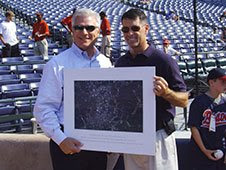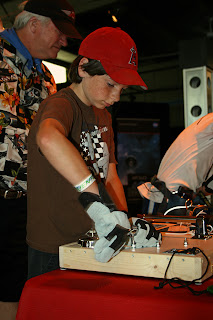
You can tell just by the title of this one that it's going to be a bit more exciting than the previous two (
Waiting in the Wings and
What Shall We Do About Claudius?). It opens normally enough, with Old!Claudius at his desk, being brought some old paperwork by a couple of slaves, amongst which is the last will and testament of Augustus Caesar...
We snap pretty quickly into the Past after that, as Germanicus returns to Augustus, feeling very smug about his military acheivements, which he describes to the small section of the Senate that the BBC budget will allow us to see. He and Claudius then go and catch up on each other's sex lives and the fact that Claudius doesn't like his own son (which is presumably why we never see the boy, nor is Claudius concerned when he suddenly chokes to death shortly before his wedding to a relative of Sejanus). Claudius tells Germanicus all about Postumus and Livia and Livilla - he speaks in whispers, and Germanicus' growing acceptance of the truth is indicated by his replies getting slowly quieter, from a shout to a whisper.
The next scene gives us Augustus and Livia: The Sitcom Years, as the two of them bicker over a fig plant and Augustus, with some weariness, notes that they have been married for fifty years. Germanicus has obviously had words with Augustus, as he's off on a trip to Corsica that he hasn't told Livia about, and isn't going to stop off and see Postumus at Planasia on the way, no no, not at all, whatever would make Livia think such a thing, and NO YOU CAN'T COME WITH ME.
Livia is not stupid, and interogates Livilla to see if she's blabbed, but misses the truth by refusing to entertain the idea that Claudius might have two brain cells to rub together. Augustus arrives at Planasia, where Postumus appears to have just enough shaving cream to shave once a month, providing him with Angry Stubble (unless that's as much beard as he can grow in four years). Augustus weeps in remorse, which doesn't impress Postumus in the least, as apparently he's a big wuss who cries at the drop of a hat anyway. He's crying himself pretty soon though, at the thought of getting unceremoniously stabbed to death in his hovel. Augustus explains that he can't take Postumus back until the Senate pass a decree overturning his banishment, and he wants to get Tiberius out of the city as well. Anyone who's ever seen a film or TV programme ever knows that this isn't going to end well, but unfortunately Augustus and Postumus don't have this advantage.
Livia, meanwhile, is now involving the Chief Vestal Virgin in her scheming. This is a much better picture of a Vestal Virgin; an woman in middle age (she is about to retire after thirty years) and wearing a white outfit a little like a nun, but fancier. Livia discovers that Augustus has changed his will and persuades the Vestal to open it up for her to see what he's changed.
We cut immediately to poor Augustus rolling around on his bed suffering from stomach pain, and we can all pretty easily imagine the intervening events. Livia, actually feeling guilty for once at poisoning her companion of fifty years, is embracing alcoholism as an escape. Augustus has convinced himself that omens are telling him that he will soon die and give way to someone called Agrippa (Postumus Agrippa). He's half right... His friend, who went with him to visit Postumus, is pretty worried at this and talks him out of it, and he manages to cure himself by eating only figs he has picked himself from the garden.
Tiberius is onto his mother, and wants to know whether she's drinking because Augustus nearly died, or because he didn't. She tells him that Augustus has altered his will in favour of Postumus, and Tiberius has a screaming hissy fit. It is possibly at this point that Tiberius' last scrap of sanity finally snaps.
Augustus, meanwhile, comes to talk to Claudius to thank him for his help and apologise for thinking him to be a blithering idiot all these years. He also insists that he's a Republican at heart - yes, Emperor, and I'm the Queen of Sheba.
We get a lovely scene of Benevolent Augustus gambling with his friends and letting them all take all the money, in the middle of which he is suddenly afflicted with the most sudden and abrupt bout of nausea and vomiting in history. Livia has now moved past alochol and resorted to blank staring not unlike the (anti)-
Heroic Blue Screen of Death. Augustus tries sticking to the figs-only diet which, naturally, horrifies his doctors; but is foiled when one of them cheerfully explains this plan to Livia.
The next scene is one of the most extraordinary in the series. Sian Phillips acts her heart out as Livia sits with the dying Augustus, telling him how silly the fig-diet was and how, luckily, Tiberius is on his way. She has to do it all with her voice though, because the camera never leaves BLESSED's face throughout the whole scene. He is absolutely silent, but, for the first couple of minutes, his eyes follow Livia's movement around the bed - then, about halfway through the scene, you can actually see Augustus die as Livia keeps talking, becoming increasingly tearful. The director explains on the DVD extras that he wanted the audience to see the light leave Augustus' eyes, and you really can - in a tour de force from Blessed, he remains absolutely motionless for the second part of the scene and somehow manages to look really dead and lifeless, until Phillips comes over and closes his eyes. If anyone ever doubts that Blessed is perfectly capable of doing subtle when required, show them this scene. It's a really incredible piece of acting, and a clever and truly memorable way to say goodbye to Augustus, who has been so dominant in the series so far.
Tiberius comes in and for the first time in the series, Livia looks really genuinely distressed, tears pouring down her face, as Tiberius solemnly intones 'the earth will shake'. As she walks out of the door, Livia tells him, in a low but firm tone 'By the way - don't touch the figs'.
But the episode isn't quite over yet. Livia tells the assembled dignitaries that Augustus is in a deep sleep (hah!), and they walk away, revealing... Captain Picard! In a Roman soldier's uniform! WITH HAIR! He is, it turns out, the son of the Commander of the Guard, and is called Aelius Sejanus - a name that meant nothing to me when I first saw the series, but is certainly significant to anyone who knows some

Roman history. As for Picard!Sejanus, he is tough, he is monosyllabic, he 'knows why he's here'. This all sounds ominous, and indeed it is, as Picard!Sejanus' first act in the show is to go and give poor old Postumus the exact death he didn't want, and then do for Augustus' friend Fabius Maximus as well.
Captian Picard with hair... so wrong...
Augustus' will is read aloud in the (BBC-budget) Senate, but it's the old will, not the changed version. Livia is sitting in a back room, rocking like a mad woman and hugging the new will. Claudius stops by to offer his condolences and she good as tells him that it's not the real will, because she's drunk again, and she still thinks he's too stupid to matter. Livia explains that Augustus is a god and she will be one day too, then tells Claudius to go and laughs at him, and we hear her laughter echoing at Old!Claudius as he brandishes the newly discovered correct will at her empty chair and yells 'Poison is Queen! Poison is Queen!'
This is a great, tense episode, the highlight of which is that amazing scene of Livia chastising Augustus as he dies right in front of us (well, you know, acts dying. Brian Blessed is, as far as I know, alive and well). We see the Snow Queen actually weep and her rock hard facade starts to crack for the first time. Nothing will ever be the same after this; the series will descend further and further into darkness (figurative and literal - there seems to be an increasing oil lamp shortage as the series goes on) and without Augustus at the head, things also become increasingly chaotic and times more uncertain. (Since
I, Claudius starts with Augustus firmly inplace, we don't see Octavian fighting two civil wars and murdering hundred of citizens by proxy in proscriptions, including Cicero - the Augustus we see in
I, Claudius, banishment of

family members aside, is a much more kindly fatherly and benevolent figure than the real one. The real Augustus would be delighted though - this is just how he wanted to be remembered).
The Bay of Naples, where Augustus died at Nola, which is on the route of the modern Circumvesuviana railway. Usual apologies for the picture quality. The faint smudge in the distance is actually Vesuvius, though when Augustus saw it, it would have been much more pointy, as it was pre-eruption.

 The Doctor save him?!). The story follows them as they get caught up in a dasterdly operation to kidnap children and sell them to slave traders.
The Doctor save him?!). The story follows them as they get caught up in a dasterdly operation to kidnap children and sell them to slave traders. their historical references. (Since I spent most of my childhood trying to reach Narnia through the wardrobe, I would have loved a book with locations you can actually visit!).
their historical references. (Since I spent most of my childhood trying to reach Narnia through the wardrobe, I would have loved a book with locations you can actually visit!).

































